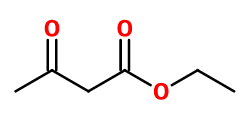
Photo credits: ScenTree SAS
| Company | Ingredient Name | ID | Comments | Naturality | Certifications | Purity | Latin name | Treated part | Geographical origin | MOQ |
|---|---|---|---|---|---|---|---|---|---|---|
|
|
Ethyl Acetoacetate - 30 Gr | - |
Visit website
|
- | - | - | - | - | - |
General Presentation
-
CAS N° : 141-97-9
-
EINECS number : 205-516-1
-
FEMA number : 2415
-
FLAVIS number : 09.402
-
JECFA number : 595
-
Appearance : Colorless liquid
-
Density : 1,03
-
Volatility : Head
-
Price Range : €
Physico-chemical properties
-
Molecular formula : C6H10O3
-
Molecular Weight : 130,14 g/mol
-
Log P : -0,2
-
Fusion Point : -43°C
-
Boiling Point : 183°C
-
Detection Threshold : 520 ppb (0,000052%)
-
Optical rotation : Donnée indisponible
-
Vapor pressure : Donnée indisponible
-
Refractive Index @20°C : Donnée indisponible
-
Acid Value : Donnée indisponible.
-
Flash Point : 64°C
Uses
Uses in perfumery :
Ethyl Aceto acetate allows to give power and volatility to floral notes. Very useful also in fruity notes of kiwi or strawberry for example. Can give an artificial facet if overdosed.
Year of discovery :
Data not available.
Natural availability :
Ethyl Aceto acetate can be found and extracted naturally from Coffee Absolute in very small quantities.
Isomerism :
Ethyl Aceto acetate does not have any isomer used in perfumery.
Synthesis precursor :
Ethyl Aceto acetate is not a precursor to the synthesis of another compound of olfactory interest.
Synthesis route :
Ethyl Aceto acetate can be synthesized by an esterification reaction between Acetoacetic Acid and ethanol. Acetoacetic Acid is obtained before this process by an aldolization reaction of formic acid on the enolic form of acetone (obtained by acid catalysis).
Regulations & IFRA
Allergens :
This ingredient does not contain any allergen.
IFRA 51th :
This ingredient is not restricted for the 51th amendment


